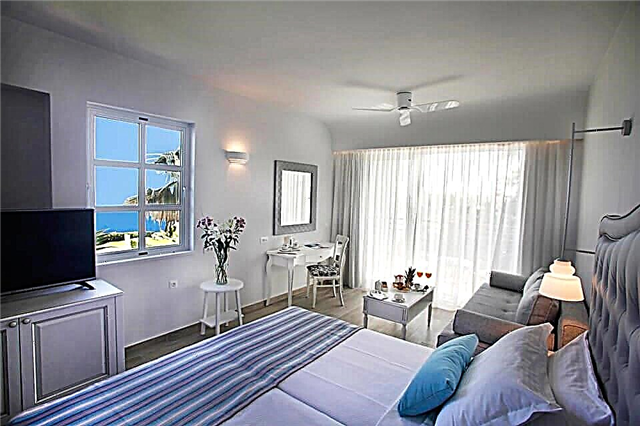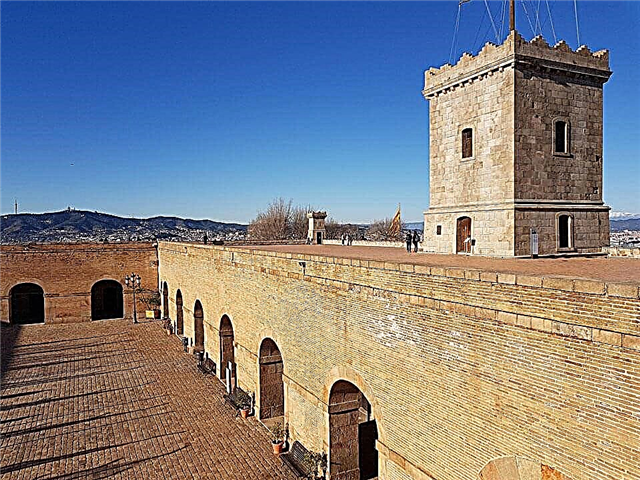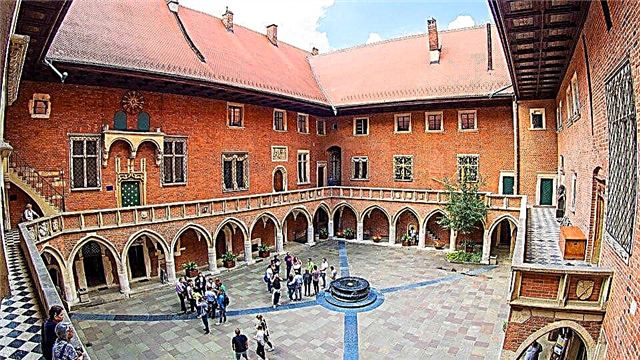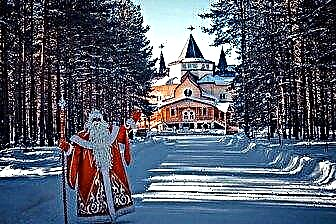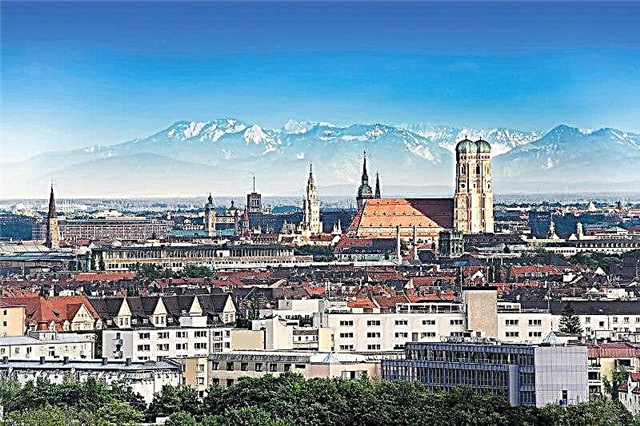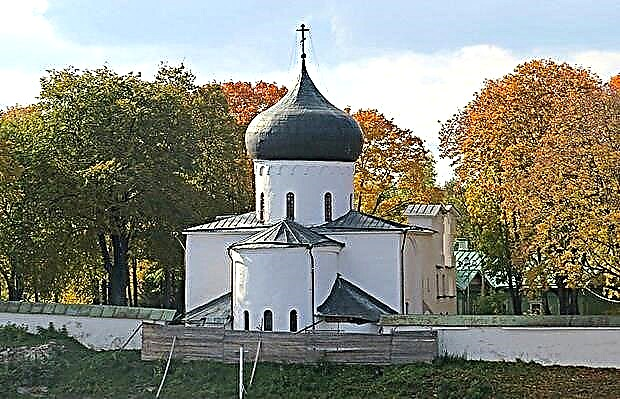Pskov is an old Russian city. He carefully preserves the traditions and centuries-old history of Russia. The city has experienced battles, wars, baptisms and the birth of the Christian faith. It is rightfully considered the spiritual heart of Russia. Pskov is widely known for its ancient preserved fortresses, temples and architectural structures. The city bears a huge legacy for posterity. It is of great interest to tourists from all over the world. We offer you to get acquainted with the most popular sights of Pskov.
Pskov Kremlin

The Pskov Kremlin is called "the heart of the Pskov land." The fortress is located on a part of the land where the Pskov River merges with the waters of the Great River. The golden domes of the Trinity Cathedral rise above the majestic white building. Previously, the Kremlin was called "Krom". Later the name has undergone changes.
Now the building bears two names. The fortress has experienced many battles and battles in its lifetime. She with dignity repulsed the attacks of the Golden Horde, the Principality of Lithuania and the Livonian knights. Krom was built to protect the people from enemies. Therefore, its beauty lies in the power and strength of the structure. When you are near such a structure as the Kremlin, you feel safe.
And the view of Krom from afar is simply amazing. Snow-white cathedral over huge powerful fortress walls, and all this is surrounded by two rivers. The territory of the fortress is surrounded by stone walls with transitional platforms. The length of the Krom walls is 435 and 345 meters. And the thickness of the wooden roof of the ceilings reaches 6-8 meters in height. You can get to Krom by buses No. 1, 5, 8, 11, 14, 15, 17. The Kremlin opens its doors for tourists from 8 to 22 hours. The entrance is free.
Trinity Cathedral

Trinity Cathedral is the shrine of the entire Pskov land. The temple is located on the territory of Krom. He owes his appearance to Princess Olga, who ordered to put the church on a promontory between two rivers. The cathedral has been the center for all the great feasts.
Here they appointed princes, held meetings, kept chronicles. The first temple was wooden, now the cathedral is snow-white, lined with cement. It consists of several churches. The most important building is 2-storey and is crowned with 5 domes. The temple is equipped with interesting 2-tiered windows, decorated with beautiful stucco and ornaments. The first floor of the cathedral is occupied by a tomb. Here the ministers of the church found peace: metropolitans, bishops.
The interior of the temple delights visitors. Here you can see old icons and paintings in chic frames. There is a huge iconostasis in the main hall of the cathedral. It consists of 7 tiers, which is rarely seen in Orthodoxy. In the churches of the cathedral there are such unique things as the cross of St. Princess Olga.
True, he is the second, created instead of the first, which burned down in a fire. The crayfish with the relics of Prince Dovmont-Timofey and Nicholas the Fool miraculously remained intact in the flames. The famous icons “Holy Trinity”, Chirskaya and Pskov-Pokrovskie icons of the Mother of God were brought from Germany to their native walls. There is a bell tower next to the temple. Its foundation was the tower of one of the walls of the Kroma fortress. There is a clock on the bell tower.
You can get to the Trinity Cathedral by buses No. 1, 5, 8, 11, 14, 15, 17 from the railway station. The entrance to the territory of the church is free. However, remember to wear appropriate clothing. The cathedral is open from 8 am to 10 pm.
Thunder tower

The Gremyachaya Tower is located on the steep bank of the Pskova River. The structure is dilapidated, but this does not prevent it from rising majestically above the water. Previously, the tower was part of the fortification of the fifth ring of the city. It served as protection from enemies and from the river at the same time. Now, the building covered with legends attracts tourists from different countries. The Gremyachaya Tower is named Kosmodemyanskaya.
This was the name of a nearby building, which was destroyed. After his name they began to call the Gremyachaya Tower. The structure is 22 meters high. The tower consists of 6 tiers and stone passages. The structure is based on a huge limestone rock.
In the tower you can see large stone arches, many loopholes and embrasures. They say that earlier under the Kosmodemyanskaya tower there was a basement with a secret passage to the river. But then it was laid with stone. Local residents are happy to tell legends about the princess cursed by his own mother and the brave prince who tried to save her. Although the building is dilapidated, it is still interesting. The picturesque surroundings, the proximity of the river and the church create a wonderful picture.
Legends captivate children, and the tower, as a historical monument, interests adults. Located near the Pskov Krom. You can reach the tower from the Kremlin along the street. Herzen to st. Gremyachnaya, along the wall of the fortress. The journey will take about 15 minutes. The tower can be viewed independently, admission is free. Or book an excursion.
Dovmont town

The ancient castle is located near the Pskov Kremlin. It is part of the complex. The city got its name thanks to the Lithuanian prince Dovmont. The prince is considered the protector of the city. After leaving Lithuania, he settled in the Russian lands.
Here he was baptized, married and won a large number of victories in battles, defending Pskov from enemies. It was the Grand Duke who built the second defensive ring of the city. Now it is called "Domantova Wall". The prince erected 17 temples around the ring, but after they were demolished. Later, during excavations, the remains of 2 churches were found.
Now in Dovmont town you can see ancient preserved buildings made of stone. The huge walls of the city's fortification remained partially. However, by these remnants one can judge what strength and power the Russian city possessed. The largest wall in front of Dovmont town is called Percy. There is a memorial sign on it - the shield and sword of Alexander Nevsky.
Dovmont's city is also called "Pskov Pompeii". The place is somewhat similar to the destroyed ancient Roman city. It is interesting and beautiful here. On a quiet morning, when there are few tourists in the city, there is a feeling of calm and security. The foundations of the temples, the remains of the walls, the domes of the cathedral towering further - all this briefly transfers to the ancient times of ancient Pskov.
Kaverin Museum "Two Captains"

Many people know Veniamin Kaverin, but not everyone knows that he is a native of Pskov. Having written the novel "Two Captains", the writer gained immense popularity. And the inhabitants, in turn, paid tribute to the wonderful book. The Museum "Two Captains" was opened in 2002 in the regional youth library of the city. Its opening was timed to coincide with Kaverin's birthday. The institution is called "the museum of one book". However, there are quite a few exhibits here. The exhibition is divided into two parts.
The first shows the life and career of Benjamin Kaverin. His family, environment, history of the creation of the work, dreams and their realization. In the second part of the exhibition, you can see the manuscripts and rough versions of the works of the great master. Here they talk about the prototypes of the heroes of the "Two Captains". The novel has been published in many languages. In the museum, you can see various editions of the book from different countries.
Suitable for fans of the musical "Nord-Ost". It also displays some props from the famous autographed action by the actors.
You can get to the museum by buses No. 1, 8, 11, 14, 17 to the stop "House of Soviets". The institution can be visited on any day except Friday and the last Tuesday of the month. The museum is open from 11 am to 5 pm. All exhibitions can be viewed free of charge. If you want to listen to the information, you can buy a guided tour ticket.
Menshikov Chambers

The famous chambers are located on Romanovskaya Gorka - this is a fairly well-known respectable area. The merchant Semyon Menshikov is considered the founder of the building.The complex erected by him consisted of a 5-storey building. Two of them were stone and three were wooden. The first chambers were soon joined by the second. They were built by Semyon's son Foma Menshikov. Semyon's chambers were 3-storeyed with a beautiful stone porch with columns and stairs. The 3rd floor was especially luxuriously furnished. They call it "amusing chambers". The house of Thomas differs from other buildings in its atypical appearance.
The wards of the youngest of Menshikov's sons are located a little further from the first two buildings. They are very similar to the house of Thomas, but smaller in size. The last, fourth chambers are located opposite the house of the head of the Menshikov family. They were badly damaged during a fire in the 18th century. This tragic incident forced the heirs of the princes to sell their chambers and leave.
This place is of interest not only to tourists, but also to historians and lovers of Old Russian art. Now in the wards there are shops with souvenir products, as well as flowers, books and clay products. You can get to the memorial place by buses No. 1, 3, 4, 5, 11, 14, 15, 17 to the stop "Children's Park". The working hours of the chambers are from 11 to 18 hours from Monday to Friday. The entrance is free.
Monument to Pushkin and Arina Rodionovna

The monument to the famous poet Alexander Pushkin and his nanny is located in the Pskov Summer Garden. The sculptor named his creation "Pushkin and the Peasant Woman". Warm relations were connected with the nanny of Alexander Sergeevich, she was very close to him. Arina Rodionovna Pushkin glorified in many of his works. Pskov has always occupied a large place in the heart of Pushkin.
He often came here, some of the best works of the poet were written in the city. The monument "Pushkin and the Peasant" is about 4.5 meters high. It is made of bronze by sculptor Oleg Komov. The master spent about 10 years on translating his idea into reality. During this time, hundreds of sketches were redone and many ideas were rejected.
Komov thoroughly studied all the available information about Arina Rodionovna. The sculptor even found a model who, in his opinion, looked like Pushkin's nanny. Now at the site near the sculpture, mass festivities and celebrations dedicated to Pushkin and poetry are held. You can get there by buses No. 1, 11, 14, 15, 17 from the railway station. From Krom you can arrive at No. 3, 5, 11 to the stop "Summer Garden".
Pogankin chambers

One of the fairly well-known attractions is the museum complex of the Pogankin Chambers. The story goes that a poor cooper once found a large treasure and built a luxurious apartment with this money. And since the wealth found by chance was considered bad (filthy), then the newly-minted merchant began to be called Pogankin. The chambers are huge structures.
Outwardly, it does not seem very attractive. However, at that time, such a building was considered an indicator of wealth and beauty. The building has been perfectly preserved to this day. Only the porch of the merchant's house was restored.
Now there is a museum in the chambers. Here you can see old icons, unique silverware, folk costumes and old household items. Inside the house of Pogankin itself there are silver items from the city's treasures, rare weapons and church books. Pagankin Chambers is an architectural monument. You can get into them through the territory of the Pskov Museum.
Here you can buy tickets for the excursion. They are held several times a day. There are quite a few different exhibitions, expositions and museums on the territory of the complex. You can buy tickets for each separately, or you can buy one (single) ticket.
The operating mode of the complex is from 11 to 18 hours. The day off is Monday. You can get to the chambers by buses No. 1, 3, 4, 8, 11, 15 to the stop "Children's Park".
Order chambers

The order chambers are located on the territory of Dovmont town. This is the only building that has been completely preserved. Previously, the basements of the building served as a prison where criminals were imprisoned in shackles. Voivods lived on the upper floors of the building. Officials served in the chambers themselves.
The structure has survived a series of fires and rebuildings. In 1995, the wards underwent a huge reconstruction. They tried to return the chambers to their original form. Show the people the life of the inhabitants of the chambers in the 17th century. The building now houses a unique tiled stove and hand-forged items.
There is a gallery on the territory of the Order Chambers. It reveals to tourists the works of museum workers, restorers and artists who worked on the reconstruction of the building. Here you can buy unique icons painted according to all the traditions of icon painting.
The chambers are easy to find, they are located on the territory of the Pskov Krom - one of the main attractions. The information center is open from 10 am to 6 pm every day. The exhibitions are open from 11 am to 6 pm from Wednesday to Sunday.
Railway museum

Previously, the museum occupied part of the railway station. Now it is located in the center of the railway workers' microdistrict. It is impossible not to see the museum. Near its entrance there is a large semaphore and a trolley on wheels. The Railway Museum is the pride of Pskov.
Here they tell about the traditions, foundations and culture of the city. The memory of ancestors is carefully preserved and honored in the museum. The history of the city is closely connected with railways. During the Second World War, a large flow of weapons and equipment passed through the Pskov lands. And after the end of the war, the city's railway workers actively helped to restore the areas suffered at the hands of the Nazis.
The main exhibitions of the museum are dedicated to this. The institution owes its appearance to a WWII veteran named Valentinka. He has done an incredible job of gathering information. The man studied the archives, talked with eyewitnesses and systematized the information he received. The museum welcomes visitors on Tuesday - Friday from 11 am to 5 pm. On Saturday, its doors are open from 11 am to 3 pm. Days off: Sunday, Monday.
You can get there by bus number 6 or minibus number 306 to the stop "Railway station".
Planetarium

The Planetarium is a unique institution that does not look like other similar ones. The fact is that it is located in the building of a former temple. The Church of the Nativity of the Virgin was built in the 19th century and existed until 1970. Later it was decided to make a planetarium out of the temple. In the course of large-scale restoration work, a starry sky appeared under the dome of the former church.
The planetarium has a varied repertoire. Here you can visit various programs with special effects. The institution hosts instructive lectures and reports. Their themes are galaxy, starry sky, constellations and celestial bodies. For children, special programs have been developed in which fairy-tale heroes take part
The planetarium is located in the center, it will not be difficult to find it. You can get to the restaurant by buses No. 3, 4, 11, 17 to the stop "Summer Garden". The planetarium is open to visitors from 9 am to 6 pm on Mondays - Thursdays. On Friday, the establishment closes at 5 pm. On Sunday, the planetarium begins its work at 11 o'clock and ends at the end of the last program.
During the holidays, programs start at 13 and 14.30 hours. On other days, applications are accepted. It should be borne in mind that a child is allowed to enter the planetarium only from 4.5 years old. A feature of the institution is that children from large families, participants in the Second World War and disabled people of 1-2 groups can attend absolutely free.
Spaso-Mirozhsky monastery

The monastery complex is known far beyond the city limits. It is located in seclusion in the Zavelichye area. It is believed that it was here on Russian soil that Christianity was born. Very few ancient buildings have survived on the territory of the complex. One of them is the Transfiguration Cathedral. Its architecture is amazing and unusual. The structure is built in the shape of a cross with ends of different sizes.
The temple is famous for its ancient pre-Mongol frescoes. Inside, the walls of the church are almost completely covered with them. They represent one big picture.This is a unique and stunning sight. You can pray here in the functioning church of St. Stephen. It contains the icon of the Mother of God "Mirozhskaya Oranta". She is considered miraculous.
The wonderful iconostasis of the temple is also painted with frescoes. And the doors and windows of the church are very beautifully decorated with columns and pediments. There is an icon painting workshop in the church. The complex is open to visitors from 8 am to 7 pm daily. You can get there by buses No. 2 and 6 to the “Dam” stop. The entrance is free.
Temple of Alexander Nevsky

In 1908, a military temple appeared in the city, it belonged to the Omsk infantry regiment, and since then it has served and provided a shoulder to the families of the military in difficult times. The building only benefited from the mixing of styles during the construction of the temple - a high red brick bell tower is visible from afar, and green roofs and blue domes with golden crosses on them attract even those who do not believe in God.
As a museum, the Alexander Nevsky Cathedral began its activity in 1996, when it received the first collection of icons from the patriarch, among which there is an icon of the Mother of God and the Most Holy Theotokos. In addition, the robes of priests, the Old Testament with notes by Nicholas II and collections of poems published by the temple itself are transferred here.
During the Christmas holidays, the church organizes events dedicated to the memory of the fallen paratroopers in Chechnya and Serbia, and their names are engraved on its walls. The temple can be visited from 6:00 to 22:00, and it is better to check the time of services on the official website.
House of Mason

At the beginning of the 20th century, the teacher and archaeologist Ludwig Mason moved to Russia, and decided to build his own house on the site of the former Zlatoust monastery. After his death, the house was transferred to the state, and now a museum is located within its walls. This choice was due to the finds that were discovered in 2002: in the basement of the building there were dozens of bodies dating back to the 16th century.
Now the House of the Mason keeps ancient weapons, jewelry, gold, coats of arms, orders and medals, porcelain, household items (watches, cutlery, samovar, matchbox), clay toys, dresses and hats of the 19th and 20th centuries. Many of the exhibits were directly related to Catherine II, for example, a silver dish, on which she was served bread and salt.
John the Baptist Monastery

After the murder of Princess Efrosinya Rogvolodovna, her body was transported to the St. John the Baptist Monastery founded by her, which henceforth began to serve as a burial vault for other Pskov nobility. The history of the nunnery begins presumably from the 12th century, according to ancient sources, earlier there was a cemetery, cells, household premises, stables, baths and gardens, but due to the events of the Great Patriotic War, almost all buildings were destroyed, and only the cathedral survived.
The exterior of the building, despite the simplicity of forms and monochromatic white color, looks monumental and severe, whose style was still related to the architecture of pre-Mongol times. A tour of this monastery is carried out in conjunction with others. The monastery works every day except Sunday, on the electronic site you can track the time of services and order a service, a prayer service.
Blacksmith yard

Like the rest of the monuments, the Blacksmith yard suffered from a fire, but he managed to save the forge. Today, within its walls there is a museum, one part of which is devoted to the history of the development of blacksmithing and master classes in artistic forging, and the other is represented by the works of modern blacksmiths (you can buy them or try to make them yourself).
Not only tourists, but also delegations from different countries come to see the author's masterpieces. For more than 1000 years, blacksmithing has continued to be passed down from generation to generation, and this type of activity is rare in our time.
At the entrance you will be greeted by an iron figure "brace", "cauldron-moon rover" and a revolver on wheels. With the arrival of the Christmas holidays, the museum workers create a special atmosphere of magic - a forged snowman and a Christmas tree in the courtyard dress up, an iron star is lit up, making wishes come true. About 50 unusual exhibits can be admired from Monday to Friday from 10:00 to 17:00.
Roundabout city

The Okolny town is known for the impressive dimensions of the five-meter walls, 7000 meters long, which were built to protect Pskov by the middle of the 15th century. One of the most powerful fortresses in Western Europe was attacked and could not be defeated about 20 times. The builders have foreseen everything, from underground passages to secret ammunition depots. Only half of the 16 towers survived, but among the ruins one can see loopholes and an embrasure, besides, restoration work is constantly being carried out here.
On the territory of the complex you can also visit a number of temples of the 15th century and museums: Pogankin chambers, where icons, weapons and money of the 13-17th centuries are kept; "Two Captains", where you will be introduced to the history of the creation of this novel and the life of its writer; the apartment-museum of Lenin and the Spegalsky museum. Being impressed by the historical events of Pskov, you can fix it in the numerous restaurants in the medieval style located here.
Olginskaya chapel

The first Christian church appeared thanks to the faith of the Kiev princess Olga in signs - three bright rays of the sun through gloomy clouds pointed exactly to the place where the chapel now stands. The long-suffering fate of the church still defended its right to exist, and after dozens of restoration works it was presented in 2004 in an updated form, which, of course, has nothing to do with the one that was erected under Olga.
The austere facade of the building is light pink with zakomaras and narrow arched windows, similar to the design of the St. John the Baptist Monastery. On days of religious events, the niche under the chapel is filled with sacred water. There is an exit to it both from the building itself and along the side external stairs.
Monument to Princess Olga

For several years the city has followed a good tradition of opening cultural monuments for the city's birthday, and 2003 was no exception. Now the statue of the "bronze" Olga adorns Oktyabrskaya Square in the Children's Park. The story of a strong-willed and wise woman began with her romantic meeting with Prince Igor, who was in love with her at first sight, mistaking her for a simple boatman. After the death of her husband, even the Byzantine ruler sought the princess's hand, but Olga wore mourning and swore to her people that she would never again be married, especially with pagans.
She stands on the pedestal with her grandson Vladimir, who adopted the faith of her grandmother, the first ruler of Kievan Rus, who converted to Christianity. Her face looks stern and unyielding, if in religious sources she is portrayed as a fair and exceptionally positive person, then according to historical documents the princess was cruel and merciless. Nevertheless, she is loved and respected by the inhabitants, and her image has been repeatedly sung and immortalized here.
Pokrovskaya tower

During the tour of the Okolny Gorod, special attention should be paid to the Pokrovskaya Tower, which held the enemies for more than a hundred years until the arrival of the Polish-Lithuanian army led by Stefan Batory. In 1581, the opponents managed to break through a five-tiered tower 6 meters thick. But the Russian people were so strong and warlike that overnight a new wall was erected in the place of the hole, all attempts to attack were repelled, and the Poles had to leave the Pskov lands, conclude an armistice and return the loot.
The next attack on the tower took place during the Northern War in the early 18th century, but it was not much affected. Thus, for more than 200 years this structure has been intact and remembers the events of those difficult times for it. Of course, part of the walls and the roof of the building have been repaired to make it possible to conduct excursions, but architects are still working on the interior, and the deadline for the project has not yet been announced.
Snetogorsk monastery

First mentioned at the beginning of the 14th century, the nunnery went through three wars and managed to "survive" to this day. Today, novices live here, they are engaged in a vegetable garden and other households, so only the Cathedral and the Church of St. Nicholas are available for tourists.
Future nuns are brought up in strictness, they are not allowed contact with curious tourists, so you will not see treats and souvenirs here. The Snetogorsk monastery is not as interesting as other shrines, there are wall paintings inside it, but they are less than 100 years old. The excursion must be agreed in advance by phoning the administration, whose contacts are on the official website of the monastery.
Monument to the 6th company

The whole country knows and mourns about the sad feat of the Russian paratroopers from the sixth company of the 76th Pskov division. After the decree of Russian President Vladimir Putin on the erection of a monument in their honor in the village of Cherekha, where the 104th paratrooper regiment is located, the Russians had the opportunity to bow and lay flowers at the memorial. In 2000, in the Argun Gorge, certain death awaited the guardsmen, 84 fighters did not return home.
For their heroism in battle, they received the title of Heroes of Russia and the Order of Courage. The monument is designed in the form of a parachute descending on the mountain, and the lists of all participants in the Russian-Chechen clash are engraved on the granite slabs on its sides. In the center of the monument, under the canopy of a parachute, there is a composition of candles equal to the number of those killed - they are lit every night.
Church of St. Nicholas from Usokhi

In the second half of the 14th century, the first wooden church appeared near the Usoha swamp, and a century and a half later, one of the most beautiful shrines at that time arose in its place, whose dome of bright green tiles could be seen from afar. In 1570, the Church of St. Nicholas witnessed the massacre of local residents by order of Tsar Ivan the Terrible, with which the following legend is connected: the royal horse heard the ringing of the Nikolsky bell and reared, for which it was immediately ordered to destroy it.
Blood gushed from the felled bell, but even this terrible sign did not stop the ruler of Russia in cruelty. By the beginning of the 20th century, the temple had expanded noticeably, a chapel appeared, but after the Second World War it had to be rebuilt, and the interior was not restored at all - in some places old frescoes appear, but St. Nicholas Church is not rich in murals and icons. From 8:00 to 20:00 it can be visited by absolutely everyone and absolutely free.
Embankments of the Pskova and Velikaya rivers

It is impossible to visit the city and not enjoy a walk along the embankments, where on one side there is a quiet expanse of rivers, and on the other there are historical sights. Tourist boats are moored on the rocky bank of the Great River, but there are very few people, which is surprising given the fact that this is the center of the city.
After the reconstruction of the Great Embankment, play areas, street cafes appeared here, flowers and topiary were planted, benches and gazebos were installed, but the Pskov River is known for settlements of wealthy citizens and the Gremyachay Tower near its banks. If you know about the military merits of the Roundabout City, and the walls and towers included in its complex, then the Gremyachaya Tower also has terrifying legends.
Once the prince's daughter was chained here in a crystal coffin by her own mother, and she could only be freed by reading the psalter for 12 days. One of the volunteers lasted a week, after which he fell asleep and was thrown out of the window by dark forces under a weeping willow - now a forged tree is decorated with many multi-colored ribbons. Residents claim that at night the moans of the same girl are heard from the tower, and the tourists themselves feel creepy at the walls of the dungeon for inexplicable reasons.
Monument "Battle on the Ice"

Every inhabitant is proud of the great battle on the ice of Lake Peipsi under the leadership of Alexander Nevsky, because it was not without their participation that the city was liberated from the Livonians in 1242. In 1993, it was time to erect a copper-bronze thirty-meter monument to this commander and his associates.
Historians have established that it was here, on Mount Sokolikha, that the path of Alexander Nevsky passed - he is depicted as a warlike and gloomy, riding a horse, and to his right are soldiers in chain mail, helmets and with shields. On the other hand, there are people from ordinary peasants in bast shoes and with an ax in their hands to representatives of the upper classes, everyone was eager to kill their enemies.
Museum "Honey Farm"

If you want to immerse yourself in the world of the original culture of the Russian people, feel like a peasant or a gentleman, breathe deeply the freshness of native wild forests, pick berries, mushrooms or honey, try yourself in carpentry, honey or linen business, then the estate-farm of Glazov Gennady Vasilyevich will fulfill these desires, and even more.
The rooms of the house seem to have frozen the life of ancient times, on the tables are samovars, jugs, irons dating from the 19th century, tools and working machines are laid out in the courtyard. At the end of the excursion, you will be taken to the refectory, where traditional Russian treats will be offered: bagels, honey, cheese, berry jam, compotes and wines, herbal teas and the famous mead.
The estate can be rented and held a holiday, arrange an event with the preparation of barbecue, it is especially cozy here in winter, when the stove is heated. “The warm atmosphere from childhood has already been appreciated by several Russian celebrities, and you will also appreciate it,” the owner of the farm guarantees. The museum is open all year round, seven days a week.
Drama Theater named after A.S. Pushkin

Since 1906, Pskov has boasted of its own theater, in which L. Blok, F. Chaliapin, A. Duncan performed at one time, but after the October Revolution, the People's House. Most of the actors left Pushkin (as it was called earlier), and during the Second World War, the theater was generally captured and destroyed by the Germans. The next era of development began for the theater with the arrival on the stage of E. Vitorgan, T. Rumyantseva and other people's artists who achieved success and recognition not only in Pskov circles, but also abroad, where they actively toured. Russian performances receive awards and nominations.
After the reconstruction of the theater, V.V.Putin himself arrives here and celebrates the excellent work of the architect in the Art Nouveau style. You can reserve a ticket for a performance at the Pushkin Drama Theater on their official website, the box office is open from 11:30 to 19:30 every day.
Museum-reserve Mikhailovskoe

Once upon a time, several generations of the Pushkin family lived here, to whom lands were granted by Catherine I for the good service of his great-grandfather, the general. Alexander Sergeevich himself visited here often, but not for long. In 1899, the house was transferred to the ownership of the state and a museum was organized. After numerous fires, only the Petrovsky Park with linden alleys, the Nurse's House, the Kitchen and the estate itself, inside which the poet's personal belongings and the interior of the rooms are kept, have survived.
The complex of memorable places associated with the name of Pushkin also includes the Trigorsk estate (which belonged to the Osipov family, with one of which the writer served his exile and often visited him afterwards) and the Svyatogorsk monastery, where he was buried. Open from 10:00 to 18:00 daily.
Basil's Church on Gorka

In 1337, on a small hill near the Great River, the first wooden church was erected at the expense of a German merchant. He converted to the Orthodox faith and took the name Vasily, which explains the name of the church. By the 19th century, the temple was overgrown with extensions and increased 2 times, a bell tower and a gallery appeared. Today, divine services are held here, a Sunday school for parishioners' children is open, and there is an icon painting, sewing, blacksmith workshop. The church is open every day for everyone from 8:00 to 19:00.
Church of St. Nicholas the Appeared from Torg

More than one temple in the city is dedicated to Saint Nicholas the Wonderworker, he was born into a wealthy family of believing Christians, and after their death he donated an inheritance to the needy and gave his whole life to serve the Lord and people.By the way, he is revered not only among our peoples, but all over the world - it was St. Nicholas who became the prototype of Santa Claus, who throws gifts into children's socks at night. Christians believe that once he helped a poor man by throwing a wallet with money through the chimney, which from there fell into a sock hanging over the fireplace.
In the scriptures, the church is mentioned only at the end of the 17th century, and the architects confirm this information by examining the buildings characteristic of that time - a fundamental four-sided two-tier white building in a strict, sustained style with no frills with five domes. Unfortunately, the church survived many fires and lost almost all of its wealth, so there is little information about it, but several dozen old icons are available for inspection from 9:00 to 19:00 on weekdays, and on Saturday from 9:00 to 15:00 ...




